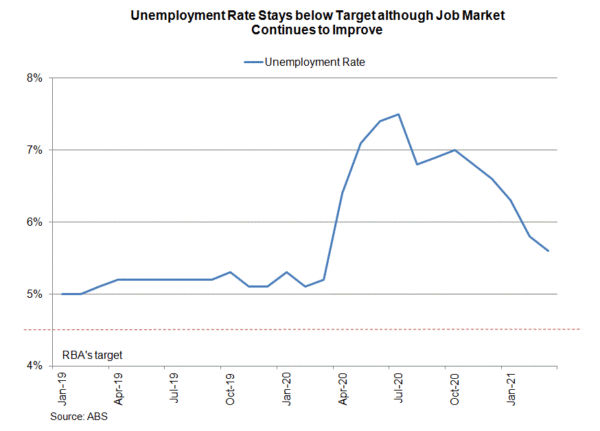While the RBA is likely to leave all monetary policy measures unchanged at this week’s meeting, the quarterly Statement on Monetary Policy (due May 7) would be closely watched. We expect policymakers to upgrade economic assessments moderately and pledge to monitor rising home prices.
Economic developments have generally improved since the last meeting. On the job market, the unemployment rate decreased to 5.6% in March, from 5.8% a month. The number of payrolls rose +70.7K, doubling consensus of a +35K increase. The participation rate increased to 66.3%, suggesting improved confidence in the employment market. Monthly hours worked also increased by 38M hours. Consumer spending picked up with the preliminary reading of retail sales up +1.4% m/m in March, beating consensus of +1% and -0.8% decline in the prior month. The momentum would likely continue in the second quarter. The IHS Markit Manufacturing PMI jumped +2.9 points to a record high of 59.7 in April. As noted in the accompanying report, “demand rose both domestically and externally, reflecting resilient economic conditions”. It added that ‘the improvements in the outlook and hiring suggest that business confidence continues to pick up in the Australian economy”.
Yet, policymakers would remain cautious as inflation remains weak. Headline CPI improved to +1.1% y/y in 1Q21, from +0.9% a quarter ago. This came in softer than expectations of +1.4%. From a quarter ago, inflation eased to +0.6%, from +0.9% in 4Q20. RBA’s trimmed mean CPI came in at +1.1% y/y and weighted median measure at +1.3% y/y. Both missed expectations. On the housing market, CoreLogic’s home price grew +1.8% m/m in April, moderating from March’s 2.8% jump. The accompanying report noted that the slowdown in price growth is “unsurprising given the rapid rate of growth seen over the past six months, especially in the context of subdued wages growth”. We expect the RBA to reiterate that it would monitor trends in housing borrowing carefully.
In February’s Statement on Monetary Policy (SMP), RBA’s baseline forecasts showed the unemployment rate falling to 6% by end 2021 and 5.5% by end 2022. Underlying Inflation should stay around 1-1.5%, compared with RBA’s 2-3% target across the entire forecast horizon. GDP was projected to expand by +4% in 2021 and +3.5% in 2022. Given the improvement in the economic conditions since then, the RBA would probably revise lower the unemployment rate to say, to 5.5% by end 2021 and around 5% by end 2022. Real GDP growth could also be revised higher to 4.5-4.75% for this year.
As both the unemployment rate and inflation would not reach RBA’s targets in the coming 2 years, the central bank would leave the monetary policy measures unchanged. As such, the cash rate target would stay at 0.1%. Correspondingly, the 3-year Australian Government Bond yield target (yield curve control) and the Term Funding Facility (TFF) interest rate would also remain at 0.1%. The size QE buying is kept at AUD100 until September.
In April, policymakers indicated that they would expand QE purchases if this could “assist with progress towards the goals of full employment and inflation”. We expect this stance would be maintained this month. Indeed, we expect the RBA to announce another AUD100B expansion in its QE program later this year.


 Signal2forex.com - Best Forex robots and signals
Signal2forex.com - Best Forex robots and signals




